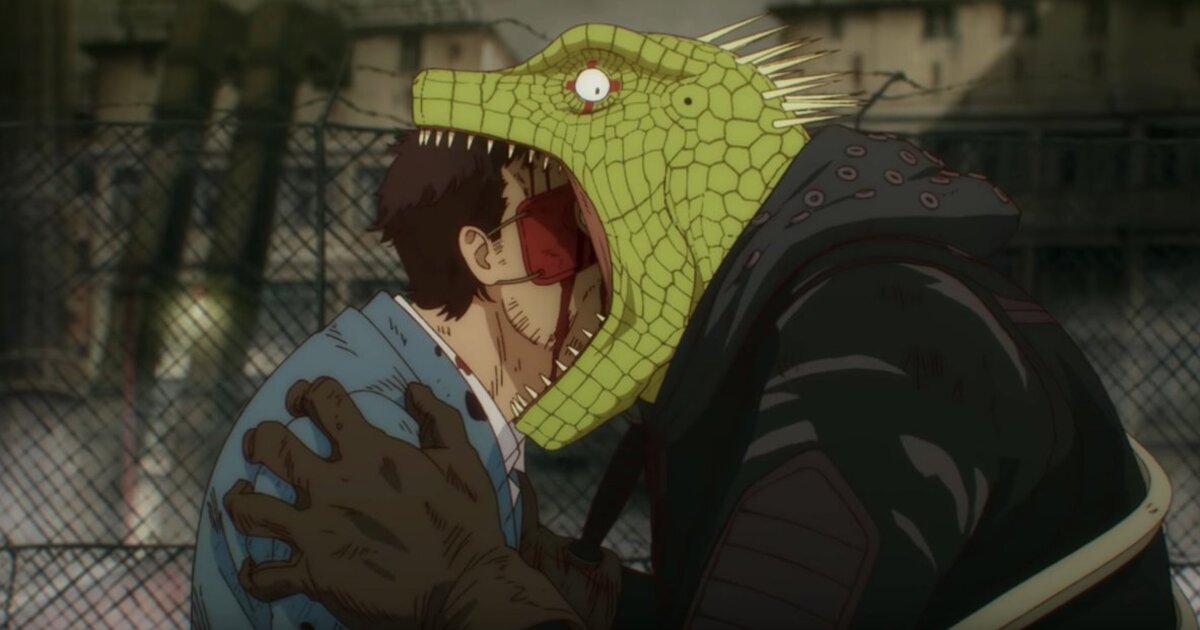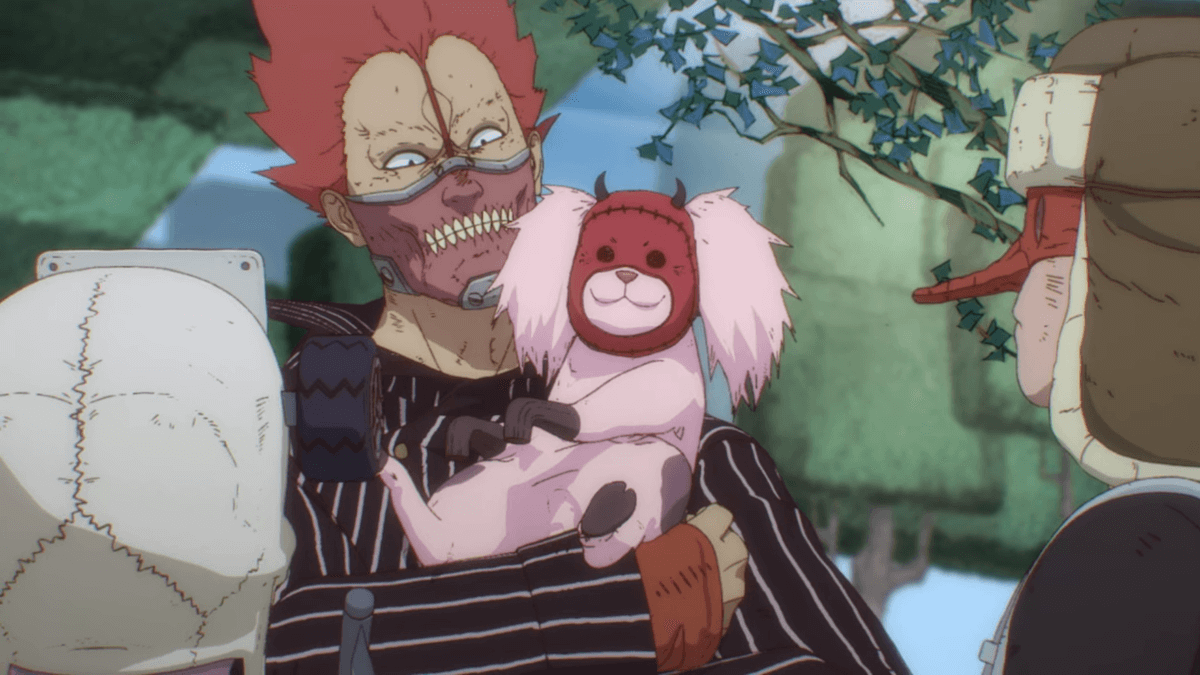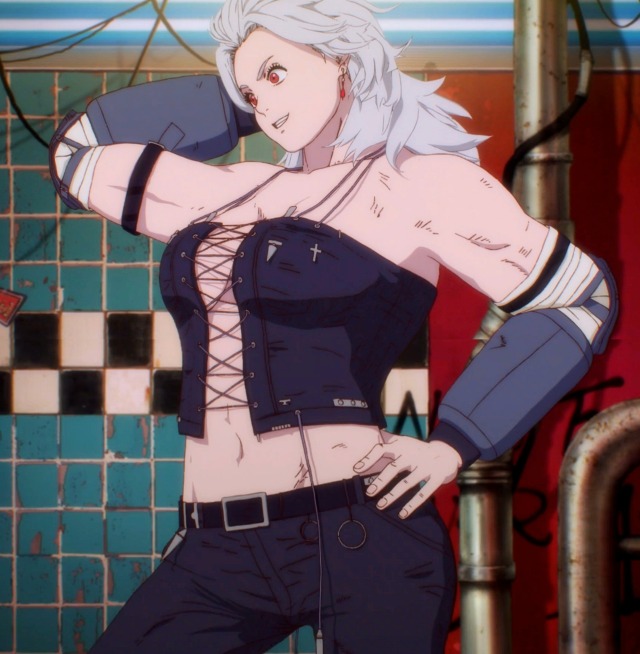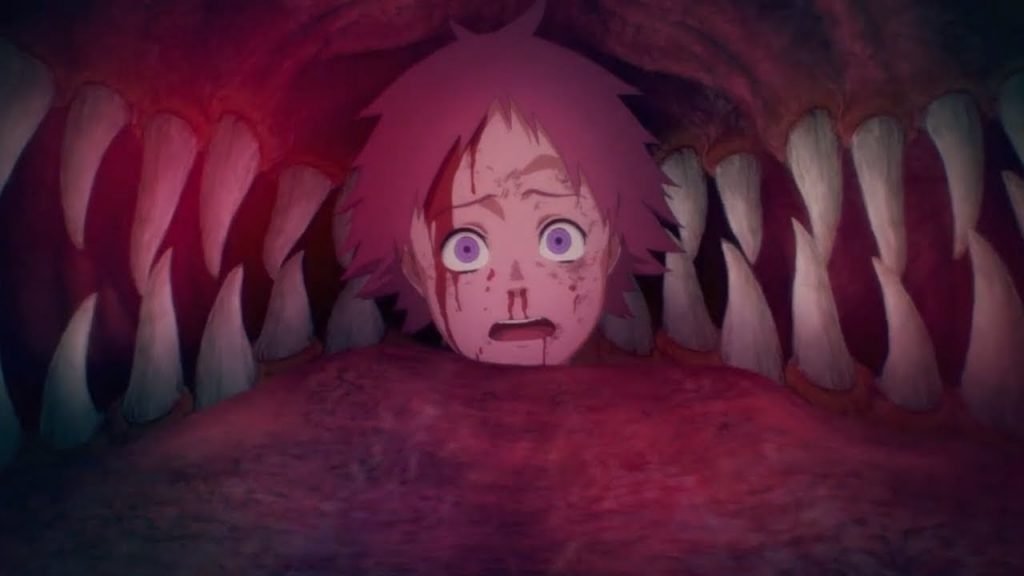Originally, I was planning to review the first season of The Witcher…then ditched that to review the first season of Space Force as well as do a retrospective on Community. But, now, I ditched writing those as well. They felt less relevant as time went on and, honestly, I wasn’t really happy with how either of them were turning out.
However, I did want to start my new site with both some positivity (for the most part) and “Surfing the Netflix” installments dealing specifically with animated series. Though they may’ve been out for a bit, they still deserve the attention as delayed as it may be on my end. Each is wonderfully distinct in tone and presentation, and all of which I’d highly recommend watching – if you haven’t already (I assure you that they’re worth it) – and will clarify as to why.
Starting with…
Dorohedoro (Season 1)

When it comes to fiction, transgressive morality is often more interesting than reaffirming accepted social norms as it calls into question certain traditions and practices we take for granted, as well as how far boundaries can be pushed before its considered too much to handle. That sense of transgression in fiction, due to its very nature, should be equally defiant of storytelling tropes and narrative rules we accept too readily – as many are the factualized tastes of older and out-of-touch figureheads of an industry. Despite the influence of Joseph Campbell’s Hero with a Thousand Faces it is, admittedly, utterly irritating how it’s treated as law by some than simply one of many possible guidelines for narrative structure. The three act rule, far from obligatory despite the name, is simply a template to build upon, rather some scientific formula to be followed to the letter. Even Shakespeare wrote five-act plays, and others only one or two!
My point is that, next to a Goichi Suda videogame, the anime adaptation to Q Hayashida’s long-running manga series displays refreshingly transgressive sensibilities to both moral standards and “common sense” storytelling – all accompanied by an aesthetic that could be best described as dystopian goth-punk chic.
Just about every character is (excluding a rare few like Dr. Kasukabe) a reprehensible person with the line between protagonist and antagonist almost nonexistent. Kaiman (or “Caiman,” but I prefer it with a K), our ostensible protagonist, simply needs to find the sorcerer who caused him to become a reptilian-headed amnesiac in a rather…unique process. However, even if the sorcerers he subjects to this is proven to not be the guilty party, he still murders them while assisted by Nikaido – a self-hating and closeted sorcerer herself – with an almost genocidal glee. En, the ostensible antagonist, is a vainglorious fungivore and powerful sorcerer who – in the dimension his kin reside – functions as an odd combination of community leader, businessman, and mob boss (he’s got hit records too!) that seeks a way to travel six years back into the past to prevent a mass slaughter: even if it means kidnapping and brainwashing a person with the power to bend time and space at his beck and call. The culprit who instigated that event may’ve been Kaiman prior to his amnesia, with the recent serial killing of sorcerers making him a prime suspect and priority target to En. Their well-meaning intentions, as valid as they are by themselves, are pursued with such abhorrent methods that lack much concern for human life and tortuously rationalizing the indefensible ultimately renders them meaningless.

Despite all that, the series goes out of its way to humanize them, and I can’t help but find them relatable. Similarly to Daredevil‘s first season, two of the (supposed) antagonists – Shin and Noi – are given a romantic subplot instead of the (supposed) protagonists, who’re entirely platonic and without an ounce of sexual tension between them. It really helps that, since the fights are as brief as they are bombastic, most other scenes act as a vehicle for small but significant character moments – like Kaiman working his part-time job cleaning up a hospital, or En and his associates preparing for a quadrennial oath-making holiday called “Blue Night” – around some incredibly well-integrated world-building.
The Hole (I’d like to think it was named after that Tom Waits song used on The Wire), Kaiman and Nikaido’s home city, is a perpetually dilapidated place that looks no different from Los Angeles in Blade Runner minus the futuristic technology but, hey, there’s still toxic rain! To contrast with “Blue Night,” The Hole has an annual “Living Dead Day” where – due to the residual effects of the sorcerers’ magic usage – zombies spring forth from the ground and are hunted down, wherein small metal plates from their body are collected and traded in for prizes (it’s as awesomely morbid as it sounds). The Sorcerer’s World, on the other hand, is absolutely delightful in how it eschews so many traits typically associated with wizards/warlocks/magi/etc. to be something satisfyingly modern and stylish. It’s an urban fantasy in the most literal way imaginable.
Sorcerers tend to wear casual contemporary clothing (save for dandies/fops like En) as opposed to scholarly robes, not much different from most residents of The Hole, but there’s a social practice where – made darkly amusing by COVID-19’s presence – sorcerers have customized masks, rather than conical hats, that are worn frequently if not constantly. That said: they do travel by way of enchanted broom and carpet. Except, in this case, brooms have developed to the point they can resemble hoverbikes (it also shape-shifts into a house-cleaning appliance!) while carpets function as taxicabs. Did I also mention all the juxtaposed Satanic and Buddhist imagery? That demons are entirely real and act like Juggalos with the business tactics of Wall St. CEOs? Or how it’s possible to become one of them by accomplishing bizarre trials of strength and perseverance, such as carrying and feeding giant fruit bats while in a 350-lbs suit of armor? ‘Cause, honestly, that’s just the tip of the iceberg…but I want y’all to still be surprised!

If it wasn’t obvious by now that the series is unconventional in telling a tale, it somehow manages to make the “Mystery Box” formula – something I’ve come to despise next to the found footage subgenre – actually work. Clues are dropped almost constantly, some of which could be red herrings, but Hayashida establishes enough of a coherent timeline of events that is leading somewhere, as opposed to a convenient way to make shit up with no real plan in mind. They may feel like mere twists and turns but, given how often flashbacks are used and connected to hints made elsewhere, are most certainly not. However, it never feels telegraphed or boring…
The reason a series like Game of Thrones fail as a narrative by the end is the over-reliance on the mystique of an eventual “big reveal.” Yet what occurs around the unveiling gradually has less and less of a connection to that event and comes off as, far from being well-realized and thoroughly constructed, creatively lazy and random – the length becoming interminable as it turns ten minutes into three hours with an agonizing pace. One may continue forth, due to the sunk cost, but it’ll always end with regret over the wasted time and energy you put into something devastatingly mediocre. It’s the equivalent of a carriage slowly being pulled by a horse tempted forward by a small carrot kept out of range on a long stick. Wait, no, at least the horse already knows its subpar reward. The mystery as to who Kaiman really is – along with the what, when, where, why, and even how – is genuinely intriguing with its deft use of anarchic unpredictability as a pretense even with the trail of breadcrumbs it leaves. You don’t have to choose between anticipating the destination or concentrating on the journey, as the false dichotomy often tells us – why not do both?
An on-going issue for me is that many anime series, and films, on Netflix (not to mention non-Japanese animated works like The Dragon Prince) suffer from the usage of cheap-looking CGI. It’s tolerable if restricted to various kinds of transportation or monsters, when occasionally interspersed with traditional animation, but usually an eye-sore when applied to humanoid characters throughout. They all look like animatronic dolls with a ceramic shell but their gears, pistons, and so forth are in such disrepair that every movement creaks or grinds – sounds so piercing that it makes your teeth rattle and ears bleed. As inconsistent or limited as traditional animation can be, there’s a certain quality – much like with stop-motion (or “claymation”) – where the flaws can be charming while over- and badly-implemented CGI distracts to the point I can’t enjoy anything else.

Thankfully, much like with the “Mystery Box” formula, Dorohedoro‘s usage of CGI evades this problem due both to Hayashida’s art style being complementary to it and the liberal usage of more traditional methods alongside it. It’s a great blend and the only other series I’ve seen equitable to it, Beastars (that’s for next time!), understands that CGI works best for fast-paced action or minor movements that’re almost seamless when cutting to shots utilizing frames of traditional animation.
I only just started reading the manga, having been tired of watching the same dozen episodes several times over, and Hayashida’s early artwork on the title is…rough. Really rough. Which makes it fortuitous that those producing the anime use her more refined style seen in later chapters, not to mention improving the visuals of certain locales like En’s vivid mushroom garden or the grungy-yet-cozy atmosphere of the Hungry Bug restaurant. Early on in the manga, backgrounds had a tendency to be these blank white spaces, making it less interesting to read than it is to watch the episodes – since it never gives a sense of time and place the way more detailed backgrounds engender. There’re other minor changes made, like the sequencing of events, as well as omitting some superfluous lines. They also toned down the nudity by not displaying any nipples, though I’d rather Ebisu (the fact she’s apparently thirteen years old is greatly obfuscated) wasn’t topless at any point, but at least she isn’t sexualized as much in the anime as she was in what I’ve seen of the manga.
It’s rare for me, moreso now than before, to find anime that manages to enthrall me as much as Dorohedoro does. It’s unabashedly bizarre and subversive with a sense of style and energy all its own, a unique creative vision that makes it a gem amongst the rubble. As fun as something like Seven Deadly Sins can be, what with being a shōnen-style take on Arthurian mythos, it’s still hampered by so many tropes and character stereotypes (both problematic and overused) that make it almost indistinguishable from other series in the genre. It’s kind of telling that one of the only other Netflix Original anime series that I’ve felt as strongly about is Carole & Tuesday and that’s not a surprise given it was directed by Shinichirō Watanabe (of Cowboy Bebop fame). It’s a nice feeling to have, in these otherwise depressing times…
Part of that isn’t just the prominent aspects of the series, which I’ve already described as much as I can without spoiling too much, but that even secondary or tertiary elements are a pleasant surprise. Most 24/26-episode anime series, if not simply using one song each for the opening and end credits throughout, will change both by the halfway mark. Dorohedoro has only twelve episodes so far and a single song for the opening credits – but has six different songs for the end credits. I can only imagine the scenario making it possible; that K(NoW)_NAME, the musical group involved, were workshopping a perfect song for the end credits but came up with several. The series director, Yuichiro Hayashi, perhaps couldn’t decide on picking one over the others and said “fuck it, let’s use them all!” How could he not? They’re all fantastic – I’d go as far as to say all are better than the song for the opening credits – and it’d have been a shame to throw any one of them out. Even the end credits change up the visuals to coincide with the episode they’re featured in and, by God, I’d love to see more of that done in the future.
So, it’s only apropos to finish with my favorite song of the bunch for the end credits – “Night SURFING”:
[EDITED: 2/10/2022]

Nicely put! I really enjoyed this anime, though I’m not that familiar with the manga, and the style was also really intriguing to me. Glad to know the style gets better as the series goes on!
One thing that did bother me about the series however is some parts of the sorcerer’s culture do come off as…near sexual assault. Noi and Nikaido’s Blue Night arcs in particular. Though I figure this can be chalked up to the series’ mantra of “everyone is an asshole”, it still made my skin crawl quite a bit.
Anyways, great review!
LikeLiked by 1 person
That’s a valid concern, actually – it can definitely be read that way.
I’ve noticed the Sorcerer’s society has a thing about dualistic relationships that are not necessarily sexual or romantic in nature, but it’s a bond taken seriously and making it official by demons is considered the biggest commitment.
But, despite whatever rules there are in place when it comes to that, there’re loopholes to be abused in the ways to control other’s against their will not to mention general corruption on behalf of said demons. Given one scene near the end, I assumed that such contracts were generally consensual – as it was with Shin and Noi – and En forcing it onto someone was an exception being made due to his standing.
That’s all speculation on my part, of course, since I’ve only gotten a *little* further than where the anime (currently) ended.
LikeLike
The one Anime I really miss from Netflix (since I don’t have Internet, it’s not worth the data to watch) is Aggretsuko. Even though it’s from Sanrio, it’s amazing, at least to me. If you have seen it, I would love to read your thoughts on it.
LikeLiked by 1 person